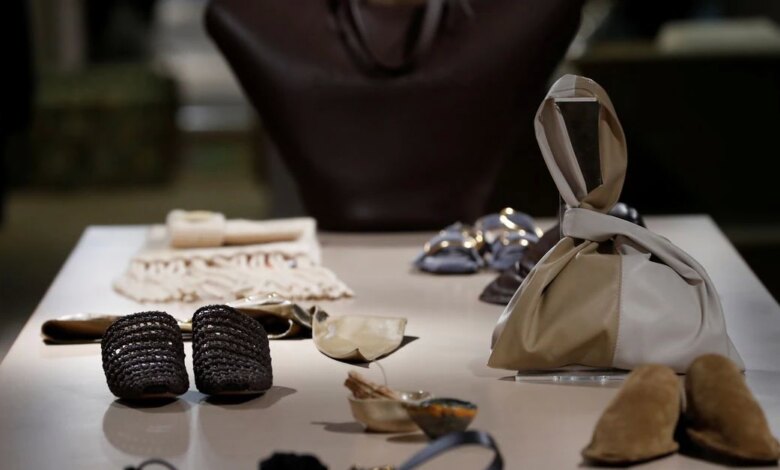East European designers sashay onto the catwalks of high fashion

PRAGUE/GDANSK, Oct 19 (Reuters) – With celebrities reminiscent of Rihanna, Justin Bieber and Billie Eilish carrying its designs, Hungarian trend home Nanushka has stardust many designers can solely dream of.
But the corporate is only one of a lot of upstart designers from central Europe elbowing their technique to the highest of world trend, showcasing their collections on the catwalks of London, Paris and New York as they aim profitable markets reminiscent of China and the US.
As soon as a struggling native model, Budapest-based Nanushka has seen annual income develop 33-fold to 33 million euros ($38.32 million) since a non-public fairness agency got here aboard in 2016.
Specializing in sustainable designs together with its vegan leather-based attire, Nanushka has turn into Europe’s fastest-growing trend firm, in keeping with the annual FT 1000 record of Europe’s high-growth firms.
Different ready-to-wear designers which have emerged from central Europe onto the worldwide scene embody Slovakia-based Nehera, worn by Hollywood stars Keira Knightley, Tilda Swinton and Marion Cotillard, and Poland’s Magda Butrym, sported by Megan Fox and Hailey Bieber amongst others.
For these corporations, creating a distinct segment in excessive trend has been facilitated by Fb Inc’s Instagram and different on-line platforms which assist younger, unbiased designers exterior of worldwide trend centres to be seen by a worldwide viewers hungry for one thing totally different.
“With out social media in all probability you recognize 15-20 years in the past it might have been nearly not possible to construct a worldwide trend home from Budapest,” Nanushka’s Chief Govt Peter Baldaszti – married to founder and designer Sandra Sandor – informed Reuters.
The model – which opened a New York retailer in 2019 and one other in London in 2020 regardless of the pandemic – counts the US as its greatest market however says China is the long run. Dad or mum firm Vanguards Trend Group, of which Baldaszti can be CEO, additionally snapped up Italian trend model Sunnei for $7 million in 2020 as a part of a method to construct a trend portfolio throughout Europe.
Central Europe boasts an extended custom of expertise within the textile business relationship again to the First Republic period between the 2 World Wars when the area was an epicentre of tradition and design.
Following the autumn of Communism in 1989, Western luxurious manufacturers and trend homes arrange store to supply luggage, scarves and garments within the area, capitalizing on the proximity to west European markets, decrease prices and a talented workforce.
Now native luxurious manufacturers in these markets are shifting within the different route to faucet into a worldwide luxurious items sector pegged to develop to round $383 billion in 2025 from $309 billion this yr, helped by demand in China and amongst Millenials, in keeping with Hamburg-based database firm Statista.
“We began with displaying in Paris … however Instagram is one thing that basically opened the door for manufacturers from international locations that aren’t actually on the style map in any respect,” Polish handbag-maker Chylak founder Zofia Chylak informed Reuters.
A Chylak purse, fabricated from Italian leather-based, prices round 200-250 euros and the model’s reputation amongst some Polish influencers dwelling overseas has helped it turn into a worldwide identify.
DESIRE FOR AUTHENTICITY
Bratislava-based Nehera – named after Czech businessman Jan Nehera who within the Thirties was first on this planet to pioneer ready-to-wear clothes – offered its 2022 spring assortment in Paris and plans to return to New York after pulling again through the pandemic.
“We’re aiming to re-enter the U.S. and European markets,” Ladislav Zdut, founding father of the model which final month opened a showroom in Milan and is in early talks with native traders to assist gas growth plans, informed Reuters.
“However we considerably elevated orders to South Korea and China and had been rising through the pandemic.”
A younger technology of designers from smaller international locations – a lot of whom labored or studied overseas – have additionally accrued the contacts and data to serve a global luxurious market, mentioned Achim Berg, international chief of McKinsey’s attire and trend group.
“The massive luxurious manufacturers are dominating the tendencies out there however there’s a need for brand new manufacturers for curation and authenticity,” he informed Reuters.
Scandinavian manufacturers reminiscent of Pimples Studios, Ganni and Toteme present how corporations from a small area exterior the style capitals can set up themselves, in keeping with Berg.
In central Europe, rising incomes have additionally created a steady native buyer base in a position to afford luxurious objects that assist fledgling designers set up themselves earlier than trying overseas, designers and firms say.
Poland’s Magda Butrym embraced the local-first method when beginning up in 2014 earlier than going international, Chief Govt Jakub Czarnota informed Reuters.
Woman Gaga was seen carrying a brief, polka dot Magda Butrym gown in a single latest Instagram put up and the model, additionally favoured by social media influencers, is now current in 40 markets. Asia and the Center East supply sturdy development alternatives going ahead however the firm will proceed to scour its regional roots to create one thing totally different, Czarnota mentioned.
“International customers are keen to find newness and this provides manufacturers a chance.
“Japanese European designers can search for inspiration to their regional tradition and heritage and translate them into distinct merchandise and collections,” he mentioned.
($1 = 0.8611 euros)
Reporting by Michael Kahn and Silvia Recchimuzzi, Modifying by Susan Fenton
:





